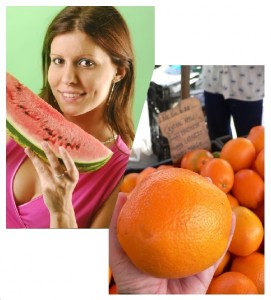 by Richard Hawkins
by Richard Hawkins
This morning the local weatherman happily announced that we were again the warmest spot in the nation while most of the county is doubtless in the mid-stages of cabin fever. While residents in Northern states are getting up early to shovel their driveway, we are choosing what to wear to the beach. No wonder Florida has the distinction of being the top travel destination!
Our climate has advantages other than promoting tourism. When you move inland from the beaches and away from the theme parks, you will find the other Florida – a world of agriculture. Our climate makes food production possible year round and enables us to produce many common fruits and vegetables for up to seven months each year.
In a quest to seek out local foods, we could not be in a better place.
Everyone knows that Florida leads the country in oranges and sugarcane. Did you know that we also rank #1 for sales of tomatoes, cucumbers, squash, watermelons, snap beans and grapefruit? We are at a close second in production of delicious strawberries and bell peppers.

The midsection of our nation is known for corn production, but most the corn produced will never become a sweet cob for your kitchen table. The commodity corn grown most often is for feeding your car through ethanol production or used to produce synthesized food products. Corn syrup, corn starch and dozens of multi-syllable food additives used in commercial food production are derived from these crops. Another use of the commodity corn crops is for animal feed in commercial feedlots. But Florida ranks #2 for the delicious sweet corn that makes its way to our tables.
When summer arrives and it is too hot for tomato production, we have the perfect climate for a myriad of tropical fruits and melons.
Let’s not forget the other food that our state produces. In 2009, Florida had 1.7 million head of cattle. While Florida ranked tenth for beef cows, we also produced over 2 billion pounds of milk. We have large scale poultry and egg production, sheep, goats and hogs. We are even fourth in the nation for the production of honey!
Agriculture has been struggling in many parts of the county, but the number of farms in Florida is actually on the rise. In 2008, Florida had 47,500 commercial farms utilizing 9.25 million acres to produce food. Also on the rise is the production of organic produce—a trend that savvy consumers are really learning to appreciate.
Surprisingly, densely populated counties are also home for much of our agriculture. Palm Beach County leads the way with nearly a billion dollars of agricultural products sold in 2007 followed by Miami-Dade, Hillsborough and Hendry.
If your goal is to find locally grown food, you don’t need to look far. It is right here.
Localecopia’s mission is to reduce food miles and connect our growers to consumers. When shopping or dining, ask for the food that lives where you do—our Florida paradise.
 Localecopia is a nonprofit organization based in Palm Beach, Florida focused upon bringing businesses, producers, educators and government organizations together for the purpose of lessening our carbon footprint by supporting local product consumption, helping operations better utilize waste and bringing together individuals to help achieve sustainable business practices. For information about Localecopia, please visit www.localecopia.org.
Localecopia is a nonprofit organization based in Palm Beach, Florida focused upon bringing businesses, producers, educators and government organizations together for the purpose of lessening our carbon footprint by supporting local product consumption, helping operations better utilize waste and bringing together individuals to help achieve sustainable business practices. For information about Localecopia, please visit www.localecopia.org.
